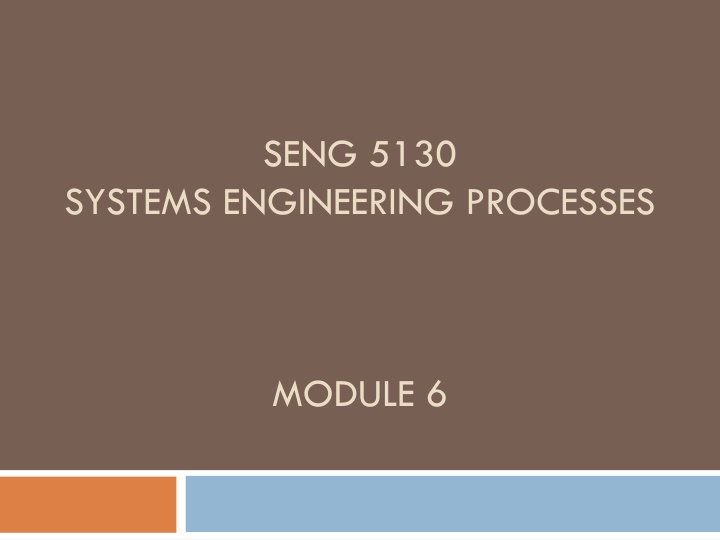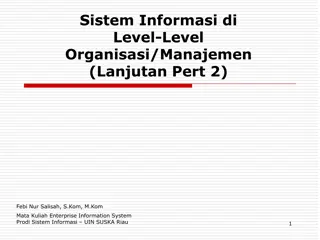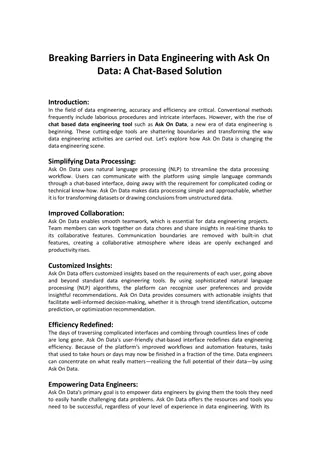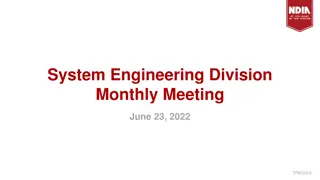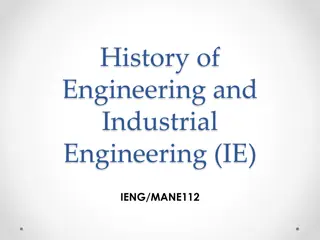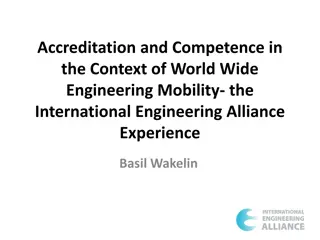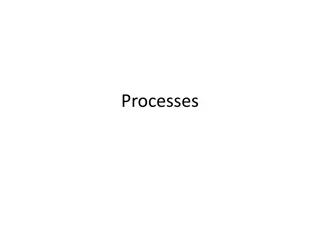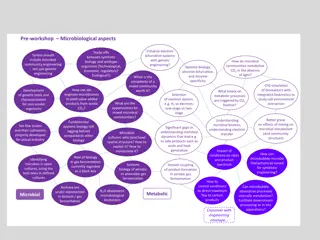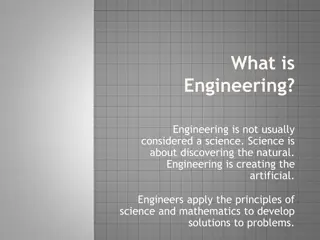Systems Engineering Management Processes Module 6
The Systems Engineering Management Processes Module 6 delves into system test, evaluation, and validation. It covers objectives, emotional aspects in poorly managed projects, technology application in the process, contextual environment, SEMP planning, and more.
Download Presentation

Please find below an Image/Link to download the presentation.
The content on the website is provided AS IS for your information and personal use only. It may not be sold, licensed, or shared on other websites without obtaining consent from the author.If you encounter any issues during the download, it is possible that the publisher has removed the file from their server.
You are allowed to download the files provided on this website for personal or commercial use, subject to the condition that they are used lawfully. All files are the property of their respective owners.
The content on the website is provided AS IS for your information and personal use only. It may not be sold, licensed, or shared on other websites without obtaining consent from the author.
E N D
Presentation Transcript
SENG 5130 SYSTEMS ENGINEERING PROCESSES MODULE 6
MODULE 6 System Test, Evaluation and Validation
Objectives of this Module Systems Engineering Management/SEMP Risk Management System Test, Evaluation and Validation 1. 2. 3.
Systems Engineering Management Systems engineering management focuses on overall effort to be accomplished employs systems engineering principles throughout the management of the process, or product line, efforts that result in a reliable, trustworthy, responsive, and high quality system. (Sage & Armstrong, 2000, p. x)
Emotional Levels in Poorly Managed Systems Engineering Projects Life Cycle in Low Maturity Organizations 10 Wild Entusiasm! 9 8 Disillusionment 7 6 Happiness Chaos 5 Definition of Requirements 4 Search for the Guilty Project Initiation 3 Promotion of Nonparticipants 2 Punishment of the Innocent 1 0 1 2 3 4 5 6 7 8 9 10 Phase
Management and Technology Applied to the Systems Engineering Process Concept design Preliminary system design Detail design and development Production and/or construction System operation and support Retirement and phase-out
Systems Engineering Management: Contextual Environment Figure 5.0 from ANSI/EIA-632-1998 Processes for Engineering a System, p. 43
Elements of SEM Planning Organizing Staffing Directing Coordinating Reporting Budgeting To meet customer requirements
System Engineering Management Plan SEMP
System Engineering Management Plan Key management document Contains all activities and milestones Promotes integration for system design and development Provides structure, policies, and procedures Integration of design-related program plans Provides communication links with other top-level planning documentation
SEMP Example Florida Department of Transportation SEMP (File in Blackboard Folder)
SEMP Generic Approach SYSTEM ENGINEERING MANAGEMENT PLAN (SEMP) PART III PART II PART I ENGINEERING SPECIALTY INTEGRATION SYSTEM ENGINEERING PROCESS TECHNICAL PROGRAM PLANNING, IMPLEMENTATION, AND CONTROL Described the system engineering process as it applies to the definition of system requirements and the development of those requirements into a final product configuration. Describes the system requirements in the various engineering specialty areas and the integration of these specialty areas into the overall mainstream engineering design and development effort. Describes the technical program tasks that must be planned and implemented in the fulfillment of system engineering management objectives. Needs analysis Feasibility analysis Operational requirement Maintenance concept Technical performance measures Functional analysis Requirements allocation Synthesis Design integration Design review Test & evaluation Utilization and support Modification/improvement Retirement and disposal Functional engineering Reliability engineering Maintainability engineering Human factors engineering Safety engineering Software engineering Logistics engineering Producibility Affordability Disposability Quality engineering Other engineering disciplines Statement of work Planning products (WBS, Network, Schedule, Costing, Reporting) Supplier requirements Organization al relationships Technical interface management Program management Risk management
Objectives of this Module Systems Engineering Management/SEMP Risk Management System Test, Evaluation and Validation 1. 2. 3.
Risk Definition Risk is the possibility of suffering loss Definition from the Software Engineering Institute s Risk Program web site at http://www.sei.cmu.edu/programs/sepm/risk
Risk Definition Risk is the potential for realization of unwanted, negative consequences of an event. from Rowe, William D.(1988), Anatomy of Risk, Krieger Publishing Co.
A Comprehensive Risk Definition Charette states that for an event, action, thing, etc., to be considered a risk, there must be: a loss associated with it uncertainty or chance involved some choice involved from Charette, Robert N. (1989), Software Engineering Risk Analysis and Management, McGraw Hill, p.55
More Risk Definitions Risk Probability (P): the degree to which the risk event is likely to occur. Amount at Stake (L): the loss if the outcome is unsatisfactory. Risk Exposure (RE): the overall liability potential of the risk; the formula for this is: RE = P x L
Risk Categorization Risk can be categorized as either: Internal: within the control of the project manager External: outside the control of the project manger
Risk Uncertainty Spectrum Contingency Budget Risk Management Plan Project Management Plan No information (Unknown Unknowns) Partial information (Known Unknowns) Full information (Known Knowns) Realm of Project Management in Managing Risk Complete Uncertainty General Uncertainty Specific Uncertainty No Uncertainty
Boehms Model Parameters Risk Identification Checklists Decision-driver analysis Decomposition Performance models Cost models Network analysis Decision analysis Quality-factor analysis Risk Analysis Risk Assessment Risk Prioritization Risk exposure Risk leverage Compound-risk reduction Risk Management Buying information Risk avoidance Risk transfer Risk reduction Risk-element planning Risk-plan integration Risk Mgt Planning Prototypes Simulations Benchmarks Analyses Staffing Risk Resolution Risk Control Risk Monitoring Milestone tracking Top 10 tracking Risk reassessment Corrective action Source: Boehm, B. (1991). "Software Risk Management: Principles and Practices" IEEE Software, 8 (1), 32-41.
Example: Satellite Experiment Software Source: Boehm, B. (1991). "Software Risk Management: Principles and Practices" IEEE Software, 8 (1), 32-41.
The Systems Engineering Integration (SEI) Risk Management Model Identify: Search for all the risks before they become problems adversely affecting your program Analyze: Process risk data into decision making information Plan: Translate risk information into decisions and actions (both present and future) and implement those actions Track: Monitor the risk indicators and actions taken against risks Control: Correct for deviations from planned risk actions Communicate: Provide visibility and feedback data internal and external to your program on current and Control Identify Analyze COMMUNICATE Track Plan emerging risk activities from Williams, R., Walker, J. & Dorofee, A. (1997) "Putting Risk Management into Practice" IEEE Software, 14 (3), 75-82.
PMBOK Project Risk Management Model Project Risk Management Risk Response Development Risk Response Control Risk Risk Identification Quantification from PMI (1996). A Guide to the Project Management Body of Knowledge, p. 112
Which One? Okay, fine, but which one do I use? Project Risk Management Risk Response Development Risk Response Control Risk Risk Identification Quantification Answer: Any one, just do it!
Risk Identification Determining which risks are likely to affect the project and documenting the characteristics of each. Risk identification is not a one-time event; it should be performed on a regular basis throughout the project. Should address both internal and external risks. Is concerned with both opportunities and threats
Risk Quantification Risk Quantification: involves evaluating risks and risk interactions to assess the range of possible outcomes. Opportunities and threats can interact in unanticipated ways. A single risk event can cause multiple effects. Opportunities for one stakeholder may be threats to another The use of mathematical techniques may create a false impression of precision and reliability.
How to Score Risks Team members then rate their top three risks on probability of occurrence and severity of outcome using the following table: Probability of Occurrence (0.0 - 1.0) Severity of Outcome (10, 20, 30) An embarrassment (below average performance) Failure to meet testing criteria 0.0 - 0.4 Impossible to Improbable 10 0.4 - 0.7 Probable 20 0.7 - 1.0 Frequent - Certain 30 Failure to meet commitments (critical success factor) Ranking = severity of outcome X probability of occurrence All project team risks are then tabulated and a prioritized list of project risks is developed
Risk Identification Worksheet Risk Management Risk Identification WorkSheet Please identify the three biggest risks within the design and development of your project/system. For each risk, rate the severity of its outcome, and the probability of its occurrence. Risk Category:____________________ Description :_________________ ______________________________________________________________________________ ______________________________________________________________________________ Severity: LOW = 10 Med = 20 HIGH = 30 Probability: Rating = Severity x Probability Rating =________________________________ Risk Category:____________________ Description :_______________________ ______________________________________________________________________________ ______________________________________________________________________________ Severity: LOW = 10 Med = 20 HIGH = 30 Probability: Rating = Severity x Probability Rating =________________________________ Risk Category:____________________ Description :_______________________ ______________________________________________________________________________ ______________________________________________________________________________ Severity: LOW = 10 Med = 20 HIGH = 30 Probability: Rating = Severity x Probability Rating =________________________________ Impossible 0.0 - 1.0 Certain Impossible 0.0 - 1.0 Certain Impossible 0.0 - 1.0 Certain
Risk Mitigation Once the project risks are identified and prioritized a detailed mitigation plan is developed: develop a list of action items assign end dates and a responsible person develop a contingency plan review plans for economies of scale
Risk Mitigation Worksheet Risk Management Date: Risk Mitigation WorkSheet Risk Description: What external influences (i.e., not within the control of the project) are causing this risk? What internal influences (i.e., within the control of the project) are causing this risk? How can the probability of this risk occurring be reduced? How can the severity of this risk be reduced should it occur? List of Action Items: Contingency Plan: Plans for economies: Category: End-date Responsible person(s):
Class Exercise Conduct Risk Identification and Mitigation for your system SYSTEMS: 1. Online Library for a University 2. Internet-based Travel Web Site 3. Multi-story Parking Garage 4. Hospital for a Small Community 5. Two-way Traffic System Across a River
Objectives of this Module Systems Engineering Management/SEMP Risk Management System Test, Evaluation and Validation 1. 2. 3.
3. System Test, Evaluation and Validation
System Test & Evaluation Systems Engineering Management function Ensures that coordinated and consistent testing effort is applied to the system for the entire life cycle. Involves both the customer and the contractor Evaluating the system progressively as it passes through acquisition and utilization phases to avoid last minute modifications Risk-mitigation measure
System Test, Evaluation and Validation Validation Steps and processes needed to ensure that system configuration (as designed) meets all initial customer requirements Final system validation: system performs effectively and efficiently when operating within associated higher- level SoS configuration
Stages of System Test and Evaluation When can we have a true system validation? At the end of the life-cycle When system is fully operational in user s environment Progressive test and evaluation plan Gain confidence in each step If a requirement is not met, take corrective action Waiting until later may be costly!
Process of System Test, Evaluation and Validation How do I know system-level requirements are met? What test and evaluation approach should I implement to verify this? Technical Performance Measures Test and Evaluation Master Plan (TEMP)
Stages of system test and evaluation during the life cycle. 5 4 3 2 1
1. Analytical Models Analytical and simulation models are necessary in the initial phase. Why? Lack of tangible entities Conceptual phase: Everything is conceptual! Computer graphics, development of 3D models Other simulation tools
2. Type 1 Testing End of preliminary design, initial stages of detailed design Bench-test models, engineering models, engineering software and service test models Verify physical design, performance and operational characteristics Operate functionally (electrically and mechanically) but do not represent production equipment Rapid prototyping may be used to verify design adequacy
3. Type 2 Testing Latter stages of detailed design Formal tests and demonstrations Performance tests Environmental qualification (shock and vibration, humidity, etc) Structural tests (stress, fatigue, etc) Reliability qualification (determine MTBF) Maintainability Personnel test and evaluation Supply chain Sampling tests when multiple quantities are produced
4. Type 3 Testing Before completing Production/Construction By user personnel at operational test site Operational test and support equipment Operational software Formal system operating and maintenance procedures First time in lifecycle where all elements of system can be operated and evaluated
5. Type 4 Testing During system utilization and support phase Evaluate alternative support policies Whether availability can be improved Select a different supply chain? First time assessing true capability
Class Exercise Identify specific tests you would conduct for all phases of your system life cycle. SYSTEMS: 1. Online Library for a University 2. Internet-based Travel Web Site 3. Multi-story Parking Garage 4. Hospital for a Small Community 5. Two-way Traffic System Across a River
System evaluation and corrective action loop
References The following references are used to compile the slides for this module: Blanchard and Fabrycky (2010). Systems Engineering and Analysis (5th Edition). Published by Prentice Hall. Faulconbridge and Ryan (2003). Managing Complex Technical Projects: A Systems Engineering Approach. Published by Artech House, Inc. Blanchard (2008). Systems Engineering Management. 4th Ed., Published by Wiley Series Kossiakoff, Sweet, Seymour and Biemer (2011). Systems Engineering Principles and Practice. Wiley. INCOSE Systems Engineering Handbook, v.3.2 Buede (2009). The Engineering Design of Systems: Models and Methods. Wiley. Sage and Armstrong (2000). Introduction to Systems Engineering. Wiley.
